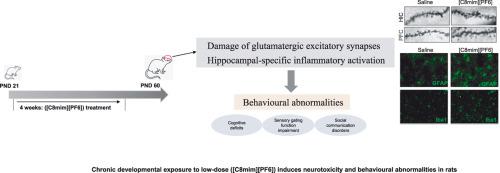Ecotoxicology and Environmental Safety ( IF 6.2 ) Pub Date : 2021-09-21 , DOI: 10.1016/j.ecoenv.2021.112806 Xi Su 1 , Wenqiang Li 1 , Zhen Li 1 , Kang Liu 1 , Meng Song 1 , Minglong Shao 1 , Luxian Lv 1 , Xulu Chang 2

|
Ionic liquids (ILs) are widely used for their physical and chemical properties. Toxicological assessments of ILs could help to avoid their threat to human health, but these are rarely reported, and no assessments of IL neurotoxicity in mammals have been performed. Here, we aimed to evaluate the neurotoxicity of chronic 1-octyl-3-methylimidazolium hexafluorophosphate ([C8mim][PF6]) (0, 1 mg/kg) exposure during development on rats. Our results indicated that chronic exposure to low-dose ([C8mim][PF6]) induces behavioural abnormalities, including cognitive deficits, social communication disorders, and sensory gating function impairment. Moreover, rats subjected to chronic ([C8mim][PF6]) exposure showed hypofunction of glutamatergic excitatory synapses, including increased expression of NMDA receptor subunits, increased density and immaturity of dendritic spines, and increased expression of PSD95. Additionally, ([C8mim][PF6]) exposure resulted in hippocampal-specific inflammatory activation, indicated by increased levels of proinflammatory factors, elevated nuclear localisation of NF-κB, and activation of microglia and astrocytes. In conclusion, chronic exposure to low-dose ([C8mim][PF6]) induced neurotoxicity, including damage to glutamatergic excitatory synapses and inflammatory activation, which may illuminate the associated behavioural abnormalities. The results presented here may be helpful for the safe use of ILs in the future.
中文翻译:

慢性发育暴露于低剂量 ([C8mim][PF6]) 诱导大鼠神经毒性和行为异常
离子液体 (IL) 因其物理和化学特性而被广泛使用。ILs 的毒理学评估可以帮助避免它们对人类健康的威胁,但这些很少被报道,并且没有对哺乳动物中的 IL 神经毒性进行评估。在这里,我们旨在评估慢性 1-octyl-3-methylimidazolium 六氟磷酸盐 ([C8mim][PF6]) (0, 1 mg/kg) 在大鼠发育过程中的神经毒性。我们的结果表明,长期暴露于低剂量 ([C8mim][PF6]) 会导致行为异常,包括认知缺陷、社交沟通障碍和感觉门控功能障碍。此外,长期([C8mim][PF6])暴露的大鼠表现出谷氨酸能兴奋性突触的功能减退,包括 NMDA 受体亚基的表达增加,增加树突棘的密度和不成熟,以及增加 PSD95 的表达。此外,([C8mim][PF6]) 暴露导致海马特异性炎症激活,表现为促炎因子水平增加、NF-κB 核定位升高以及小胶质细胞和星形胶质细胞激活。总之,长期暴露于低剂量 ([C8mim][PF6]) 会引起神经毒性,包括对谷氨酸能兴奋性突触的损伤和炎症激活,这可能会阐明相关的行为异常。此处介绍的结果可能有助于将来安全使用 IL。NF-κB 的核定位升高,以及小胶质细胞和星形胶质细胞的激活。总之,长期暴露于低剂量 ([C8mim][PF6]) 会引起神经毒性,包括对谷氨酸能兴奋性突触的损伤和炎症激活,这可能会阐明相关的行为异常。此处介绍的结果可能有助于将来安全使用 IL。NF-κB 的核定位升高,以及小胶质细胞和星形胶质细胞的激活。总之,长期暴露于低剂量 ([C8mim][PF6]) 会引起神经毒性,包括对谷氨酸能兴奋性突触的损伤和炎症激活,这可能会阐明相关的行为异常。此处介绍的结果可能有助于将来安全使用 IL。










































 京公网安备 11010802027423号
京公网安备 11010802027423号